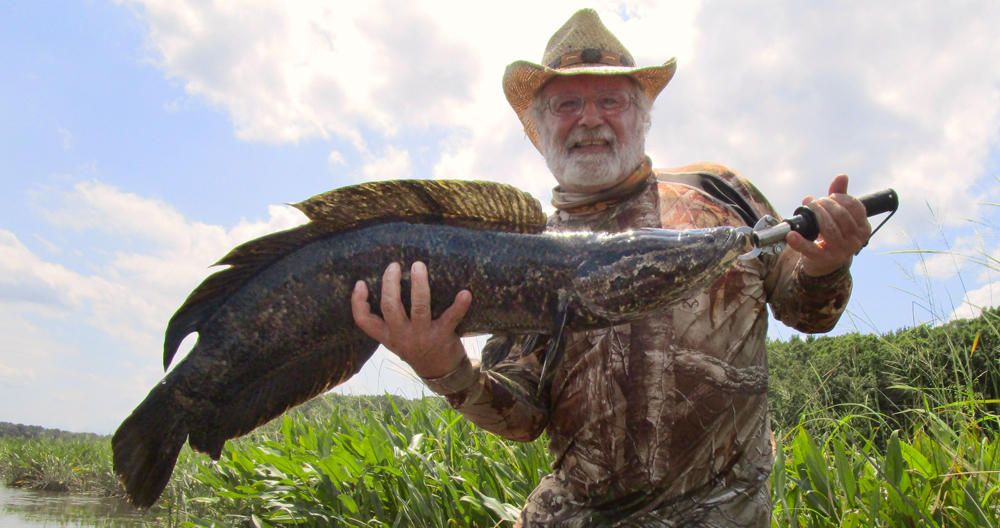FYI: they don’t walk on land, they don’t spawn five times a year, they won’t eat your cats or dogs, and for the grand-moms out there, they won’t eat your grandchildren. I’m still amazed that 14 years after snakeheads began being caught by hook and line, there are still some fishermen out there who only know and recite the so-called facts the media put out back then. All these years later our fisheries haven’t really been impacted at all – except that some fishermen have found out what a great gamefish the northern snakehead is.

I’ve been chasing them for over eight years and spend a good part of my summer pursuing them. They can be caught with most bass gear except when they are in heavy cover, where weedless flies or lures get the nod. I believe these fish also have a benefit to we fisherman that most people aren’t seeing. As our population grows, the pressure on our natural resources also increases. More and more fishermen are leveraging a resource that isn’t getting any bigger, and they all are competing for the same fish in the same waters. Overcrowding on the lakes, rivers, and the Bay are a common occurrence and the pressure on the fish is tremendous. However, there are waters around the Chesapeake that don’t receive nearly as much pressure as the prime waters. These areas are often too shallow and too weedy for regular boat traffic, they’re muddy, and they have a low oxygen content that won’t support most of the predators we normally fish for. These waters could be productive, with the right combination of resources.
This is where the northern snakehead, though it is an invasive species, could be of benefit instead of being cursed as a fish that will destroy the environment. The nature and habits of the snakehead lend themselves well to the waters I have described. They can survive and even thrive in just these sorts of conditions, turning those previously unproductive, underutilized waters into exciting fishing destinations.
Snakeheads are here to stay and we should learn to embrace them like we have with other species that were not native to the area but have come to be considered primary gamefish – just as has happened with the largemouth bass, which in fact is not originally native to our area but is the very stock which so many feared would be threatened by the snakehead.
Snakeheads will continue to spread, and as they do so they’ll fill into these rarely-fished waters. As they establish themselves they’ll create new fisheries which anglers can spread out into and thereby reduce the pressure on some of our harder hit waters. Those who have fished for them have found that snakes are worthy opponents and a great gamefish. They’re a challenge, and test all of an angler’s skills. What else could you ask of a fish? Oh, by the way, they’re great table fare, too.
- By Joe Bruce
BONUS INFO: Snakehead-Slayin’ Tips from Alex
Alex Gallardo Perez, sales manager at Angler’s Sport Center in Annapolis, MD, has earned a well-deserved reputation as a snakehead sharpie. To get some basic how-to info on snakehead fishing, we asked him to share his top five tips. Here’s what Alex said:
- Always fish near heavy vegetation and/or structure – not out in open water. These fish like shallow water, and they love habitat with tons of growth. Generally speaking the thicker the growth is, the better. (This is why it’s important to carry weedless lures and this explains the popularity of weedless frogs among snakehead fishermen, as they can be fished over and through the thickest grasses and lilies).
- In the cooler months of the year, try to find areas of warm water. As a general rule of thumb the colder the water is the tougher it gets to catch them. But there are some warm-water discharges on the Potomac where it’s actually possible to catch snakeheads year-round.
- In the heat of summer, lures are the best way to target snakes. But in relatively cool conditions, live bait works better than artificials (though you can still catch them on lures sometimes). The biggest bull minnow you can find work well, and have become a go-to bait in the Blackwater watershed. In the Potomac watershed, small bluegills and sunfish are known to tempt them into biting.
- Make sure you’re using appropriate tackle; many people use gear that’s too light. You want a fairly stiff tip, so you can set the hook firmly and quickly. And your gear needs to be strong enough to handle the fish even when it swims through loads of weeds. If you’re using light gear in heavy cover, a lot of times you’ll end up breaking off. Stout bass tackle you’d use while fishing for largemouth in heavy cover is about right.
- Observe your surroundings closely, because often these fish will give away their position visually. Sometimes they rise to the surface to gulp air, or roll and expose their back. Other times you’ll see grass moving, mysteriously out of synch with the wind and waves, near the shoreline. During the spawning season you may spot their fry balls, which the adult snakeheads stay near and guard aggressively.
And our own FishTalk snake-savvy angler Zach Ditmars reminds us:
- Fishing at dawn or dusk, and during a high tide ebbing or flowing in, will increase your odds of success.
- Aim your casts for holes and edges in the hydrilla, near shore and in three feet of water or less.
- Mallows Bay off the Potomac is a great spot to target these fish. See Kayak Fishing at Mallows Bay to learn more.